|
|
Apomixis, the formation of asexual seeds in plants, leads to populations that are genetically uniform maternal clones. The transfer of apomixis to crop plants holds great promise in plant breeding for fixation of heterozygosity and hybrid vigour because it would allow the propagation of hybrids over successive generations. Apomixis involves the production of unreduced (diploid) female gametes that retain the genotype of the parent plant (apomeiosis), followed by parthenogenetic development of the egg cell into an embryo and the formation of functional endosperm. The molecular mechanisms underlying apomixis are unknown. Here we show that mutation of the Arabidopsis gene DYAD/SWITCH1 (SWI1), a regulator of meiotic chromosome organization, leads to apomeiosis. We found that most fertile ovules in dyad plants form seeds that are triploid and that arise from the fertilization of an unreduced female gamete by a haploid male gamete. The unreduced female gametes fully retain parental heterozygosity across the genome, which is characteristic of apomeiosis. Our results show that the alteration of a single gene in a sexual plant can bring about functional apomeiosis, a major component of apomixis.
Nature News and Views: Biotechnology: A hold on plant meiosis by Peter J. van Dijk |
 |
 |
In the case of engineering of pest resistance tissue-specific promoters would enable expression of pesticidal transgenes in those parts of the plant that are vulnerable to attack. Examples of tissue-specific promoters that would be useful for the engineering of pest resistance are root, shoot apex/ meristem-specific, and wound inducible. |
|
We have cloned and characterized three promoters: 1 a root specific promoter from a glycosyl transferase gene. A 218 bp region containing the promoter sequence confers high level root preferred expression when fused in frame to a promoterless GUS reporter gene and transformed into Arabidopsis; ii) a shoot apex promoter comprising 3.8kb of the upstream region from a receptor kinase gene which conferred expression in the shoot apical meristem and young leaves but not older leaves; iii) a wound-inducible promoter comprising 3.12kb of the upstream region of a ring finger protein gene conferred expression specifically in response to wounding. |
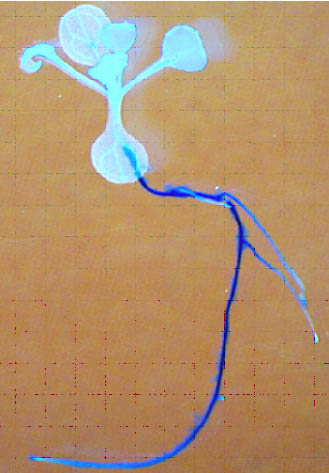 |
|
Analysis of AtMND1 function in plant meiosis :
Pairing of homologous chromosomes at meiosis is an important requirement for recombination and balanced segregation among the products of meiotic division. Recombination is initiated by double stand breaks (DSBs) made by Spo11 followed by interaction of DSB sites with a homologous chromosome. This interaction requires the strand exchange proteins Rad51 and Dmc1 that bind to single stranded regions created by resection of ends at the site of DSBs and promote interaction with uncut DNA on the homologous partner. Recombination is also considered to be dependent on factors that stabilize interaction between homologous chromosomes. In budding yeast Hop2 and Mnd1 act as a complex to promote homologous pairing and recombination in conjunction with Rad51 and Dmc1.
|
|
We have analyzed the function of the Arabidopsis orthologue of the budding yeast MND1 gene (AtMND1). Loss of AtMND1 did not affect normal vegetative development but caused fragmentation and missegregation of chromosomes in male and female meiosis, formation of inviable gametes, and sterility. Fluorescence in situ hybridization (FISH) analysis showed that homologous pairing failed to occur and homologues remained apart throughout meiosis. AtMND1 showed strong expression in meiocytes as revealed by RNA in situs. |
 |
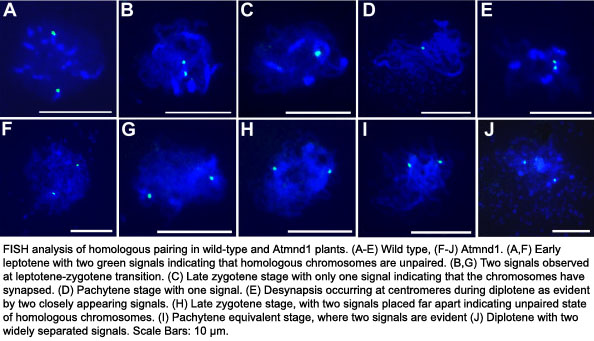 |
We conclude that AtMND1 is required for homologous pairing and repair of DNA double strand breaks during meiosis in Arabidopsis and thus shows conservation of function with that of MND1 during meiosis in yeast. |
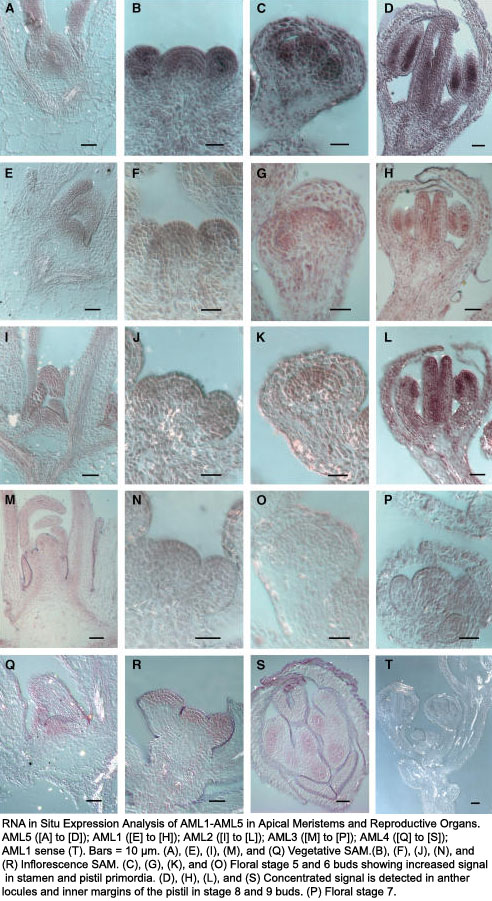 |
The control of plant meiosis particularly early steps involving the control of premeiotic DNA synthesis and entry into meiosis are not well understood. In order to understand the control of entry into meiosis in plants, we have used a candidate gene approach and studied the function of the AML gene family whose members are related to MEI2 gene, a master regulator of meiosis in S.pombe MEI2 encodes an RNA binding protein. The AML gene family consists of 5 members that show close similarity to MEI2 in the three RRMs and at the C-terminal portion of the encoded protein, a region which has been shown to be especially critical for the function of Mei2. We have studied the expression and function of AML genes using RNAi and analysis of multiple mutant combinations of aml insertion alleles. We have shown that the AML genes function at multiple stages of plant growth and development. In the vegetative meristem AML genes are required for seedling growth: aml mutants and RNAi lines show seedling arrest and defects in root growth. In the reproductive phase, loss of AML gene function leads to defects in meiosis and gametogenesis. Hence unlike in S.pombe where the function of Mei2p is specific to meiosis, the AML genes function in both reproductive meristems and appear to play a broader role, covering multiple stages of plant development including meiosis. |
|
Results from other studies point to the likelihood that the AML genes function in nutritional signaling of meiosis in plants through the integration of nutritional and developmental signals and point to a level of conservation between the control of meiosis in plants and that in S. pombe. |
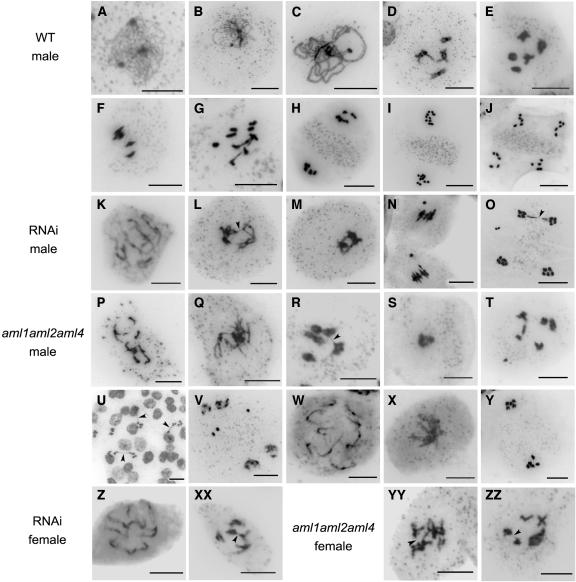 |
|
The DUET gene is required for male meiotic chromosome organization and progression:
Progression through the meiotic cell cycle is an essential part of the developmental program of sporogenesis in plants. The duet mutant of Arabidopsis was identified as a male sterile mutant that lacked pollen and underwent an aberrant male meiosis. Male meiocyte division resulted in the formation of two cells instead of a normal tetrad. In wild type, male meiosis extends across two successive bud positions in an inflorescence whereas in duet, meiotic stages covered three to five bud positions indicating defective progression. Normal microspores were absent in the mutant and the products of the aberrant meiosis were uni- to tri-nucleate cells that later degenerated, resulting in anthers containing largely empty locules. Defects in male meiotic chromosome organization were observed starting from diplotene and extending to subsequent stages of meiosis. There was an accumulation of meiotic structures at metaphase 1, suggesting an arrest in cell cycle progression. Double mutant analysis revealed interaction with dyad, a mutation causing chromosome cohesion during female meiosis. Cloning and molecular analysis of DUET indicated that it potentially encodes a PHD-finger protein and shows specific expression in male meiocytes. Taken together these data suggest that DUET is required for male meiotic chromosome organization and progression.
|
|
The properties of the DUET gene described above indicate that it is required for male meiotic chromosome organization and suggest that in the absence of DUET function, male meiocytes undergo defective progression through the meiotic cell cycle. In the duet mutant, male meiocytes went through a single division to produce a pair of cells instead of a normal tetrad. The defective spores produced did not complete gametogenesis and degenerated. The phenotype resembled that observed in the dyad mutant of Arabidopsis in which the majority of female meiocytes divide singly to give a dyad followed by an arrest in further development of the female gametophyte. The DUET gene was cloned by transposon tagging with a Ds element and found to encode a putative PHD finger domain protein. The PHD finger is a modified zinc finger and is found in a number of proteins that play a role in chromatin organization and transcriptional regulation and include members of the Trithorax and Polycomb groups. In plants the PHD finger has been found in a transcriptional regulator of genes involved in defense against pathogens and in genes that are required for reproductive development and fertility. Expression of the DUET gene in the inflorescence appeared to be specific to the male meiocyte. Earliest expression was detected in stage 4 anthers at a time that corresponds to the presence of sporogenous cells. Maximal expression was seen at anther stage 5 prior to meiosis, after which the signal declined. |
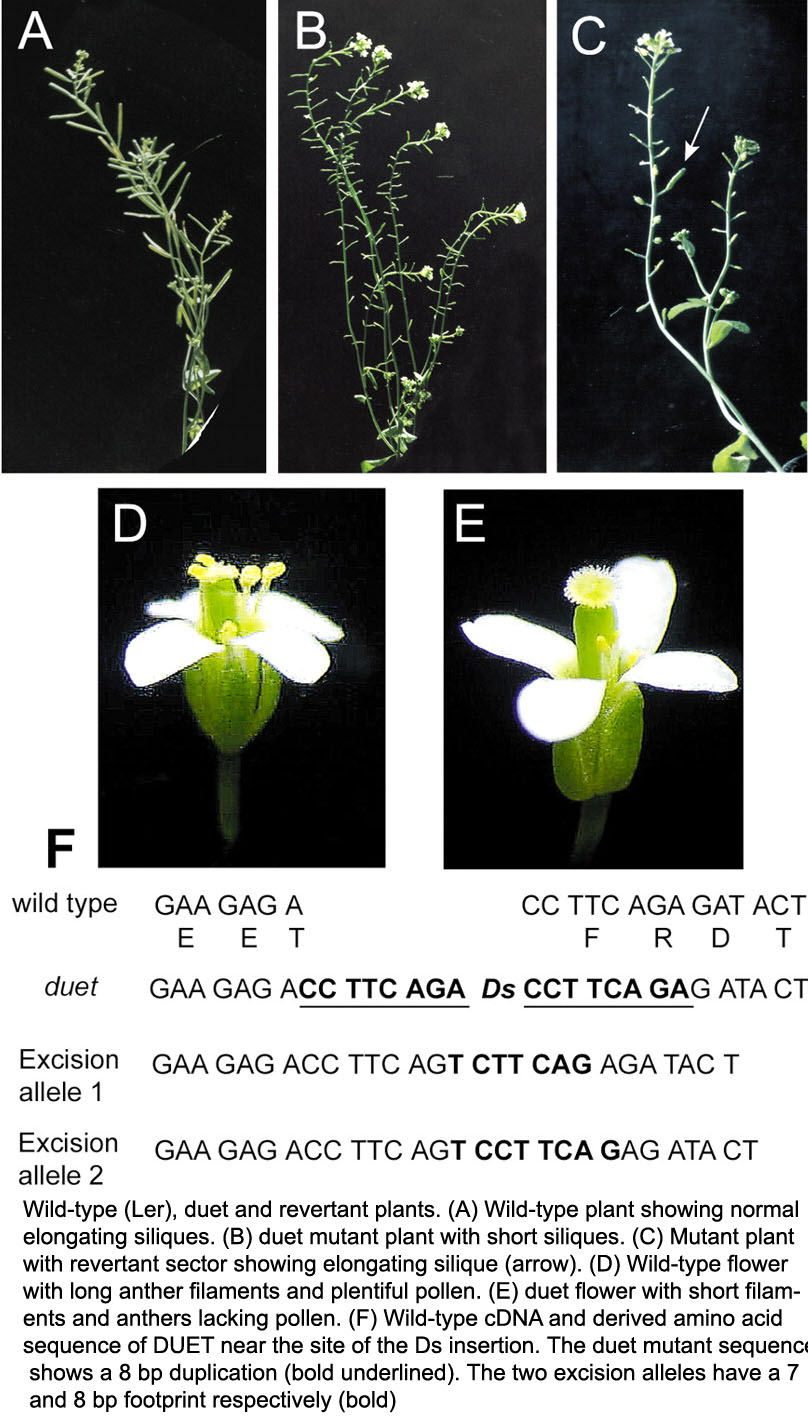 |
 |
The appearance of chromosomes during early stages of meiotic prophase in the duet mutant was normal up to pachytene. Differences from wild type first became noticeable at diplotene with chromosomes appearing more irregular and diffuse in the mutant. This would suggest that either the timing of DUET action is at the onset of diplotene or else that DUET may act earlier, but its absence may lead to visible changes in chromosome structure only at a later stage when the synaptonemal complex is disassembled and most of the sister chromatid cohesion is removed at diplotene. The difference between duet and wild type was accentuated at diakinesis and culminated in a high proportion of meiocytes showing arrest at metaphase 1. The appearance of chromosomes at metaphase 1 was variable and distinctly different from wild type. The metaphase 1 phenotype ranged from nearly normal looking structures to ones in which the chromosomes appeared as an irregular mass towards the center of the cell in which individual chromosomes could not be clearly distinguished. A distinct characteristic of the mutant meiosis was the absence of the organelle band which is a prominent feature found at the center of the cell of wild-type meiocytes at telophase 1. Instead, the organelles in the mutant meiocytes appeared more evenly distributed throughout the cytoplasm. |
|
Double mutant combinations of duet with dyad revealed genetic interaction manifesting in defects during male meiosis. The effect was most apparent in plants that were duet/+ dyad/dyad. Whereas the individual dyad/dyad and duet/+ plants showed no or very weak effects on pollen development, the combination resulted in strong defects in male meiosis. Microsporocytes showed defective division patterns and the products were dyads, triads and tetrads. Most of the microspores produced were defective and degenerated. However a minority of spores did develop into viable pollen. At the cellular level, the defective divisions of the male meiocyte were similar to those in duet/duet, although less severe. The duet dyad double mutant showed a progression defect that was more severe than in the duet single mutant as the male meiocytes failed to divide. |
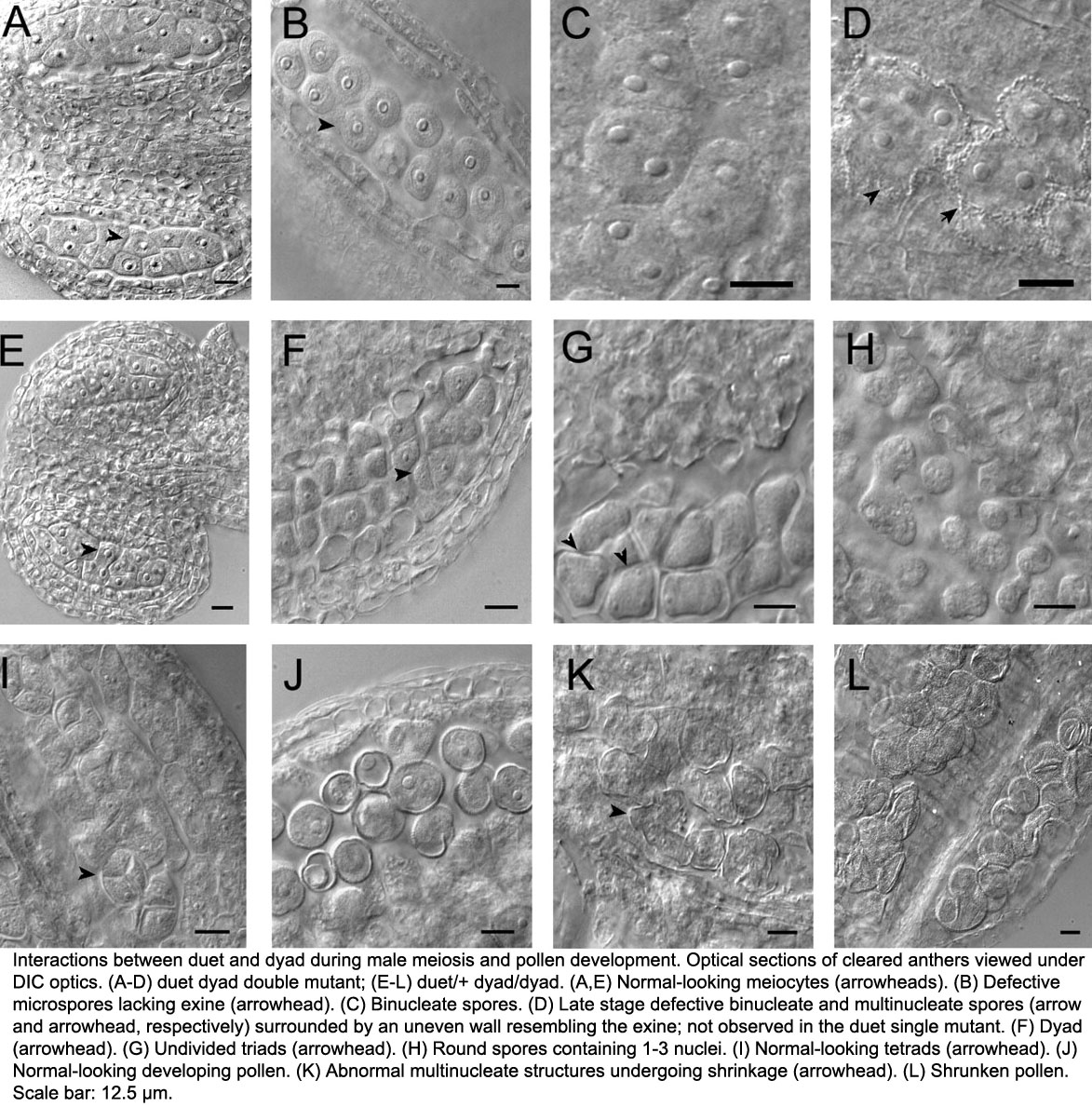 |
|
At the chromosomal level there were additional defects that were not observed in either single mutant. In duet/+ dyad/dyad meiocytes, chromosomes lost synapsis or cohesion prior to meiosis 1 and segregated unequally in many cases. Loss of cohesion was not observed in either the dyad or duet single mutants. dyad is a female-specific allele and shows normal male meiosis and pollen development.
The genetic interaction between duet and dyad could be specific and the genes may act at the same level of chromosome architecture. The presence of the PHD finger in DUET implicates it as functioning in the control of transcription at the level of chromatin organization whereas DYAD/SWI1 has been shown to function in chromosome organization and cohesion. If DUET does in fact function as a transcriptional regulator, this would point to a close connection between cohesion and the control of transcription at the chromatin level during meiosis. The formation of dyads and the fact that meiosis is more extended in the duet mutant clearly suggests a defect in meiotic progression. The further analysis of mutants defective in meiotic progression should provide information on the existence of chromosomal checkpoints in plant meiosis.
|
|
Molecular and genetic analysis of megasporogenesis in Arabidopsis: the role of dyad gene:
In higher plants the gametophyte consists of a gamete in association with a small number of haploid cells, specialized for sexual reproduction. The female gametophyte or embryo sac, is contained within the ovule and develops from a single cell, the megaspore which is formed by meiosis of the megaspore mother cell. The dyad mutant of Arabidopsis, described herein, represents a novel class among female sterile mutants in plants. dyad ovules contain two large cells in place of an embryo sac. The two cells represent the products of a single division of the megaspore mother cell followed by an arrest in further development of the megaspore. |
|
We addressed the question of whether the division of the megaspore mother cell in the mutant was meiotic or mitotic by examining the expression of two markers that are normally expressed in the megaspore mother cell during meiosis. Our observations indicate that in dyad, the megaspore mother cell enters but fails to complete meiosis, arresting at the end of meiosis 1 in the majority of ovules. This was corroborated by a direct observation of chromosome segregation during division of the megaspore mother cell, showing that the division is a reductional and not an equational one. |
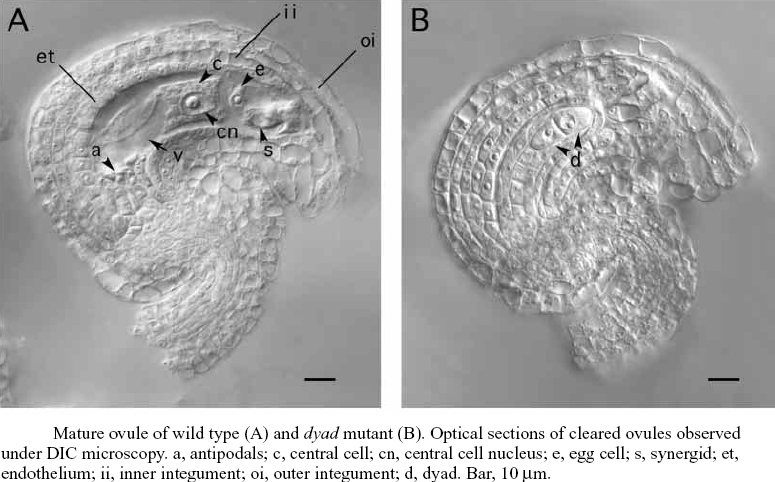 |
|
In a minority of dyad ovules, the megaspore mother cell does not divide. Pollen development and male fertility in the mutant is normal, as is the rest of the ovule that surrounds the female gametophyte. The embryo sac is also shown to have an influence on the nucellus in wild type. The dyad mutation therefore specifically affects a function that is required in the female germ cell precursor for meiosis. The identification and analysis of mutants specifically affecting female meiosis is an initial step in understanding the molecular mechanisms underlying early events in the pathway of female reproductive development. |
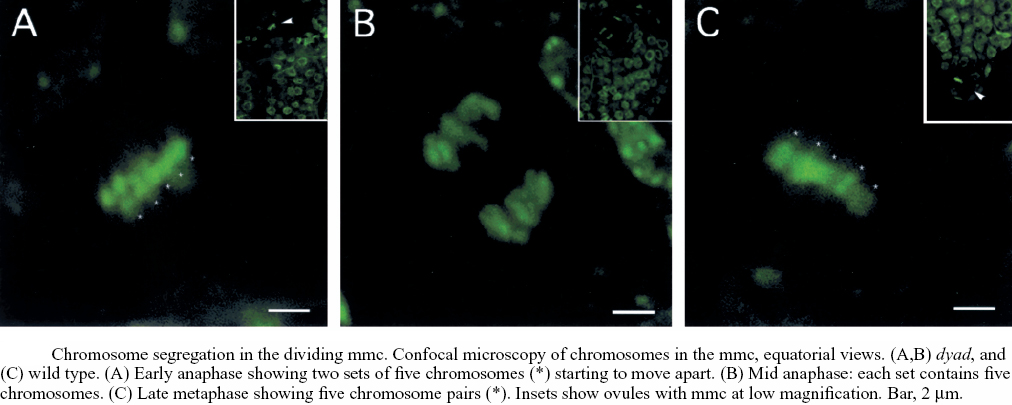 |
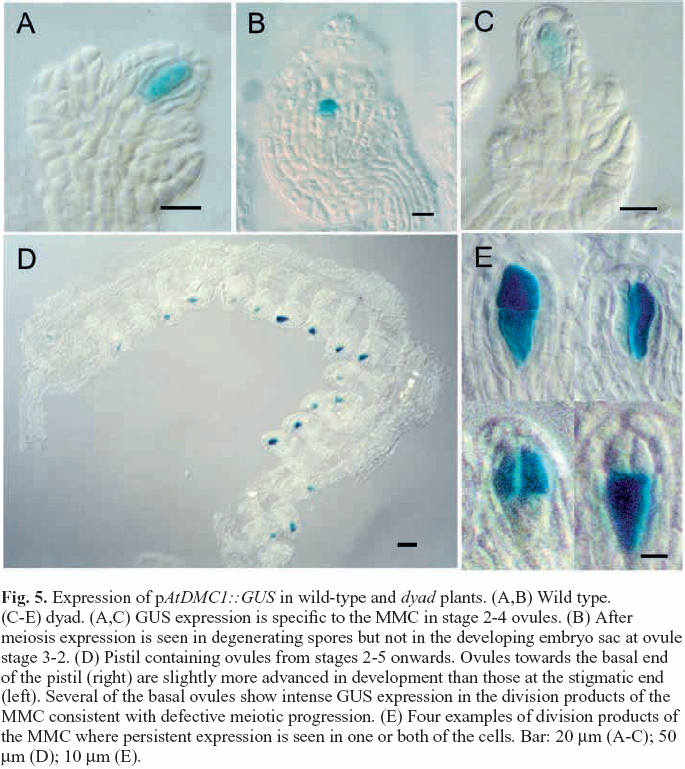 |
In ovules and anthers DYAD RNA is detected specifically in female and male meiocytes respectively, in premeiotic interphase/meiotic prophase. Analysis of chromosome spreads in female meiocytes showed that in the mutant, chromosomes did not undergo synapsis and formed ten univalents instead of five bivalents. Unlike mutations in AtDMC1 and AtSPO11 which also affect bivalent formation as the univalent chromosomes segregate randomly, the dyad univalents formed an ordered metaphase plate and underwent an equational division. This suggests a requirement for DYAD for chromosome synapsis and centromere configuration in female meiosis. The dyad mutant showed increased and persistent expression of a meiosis-specific marker, pAtDMC1::GUS during female meiosis, indicative of defective meiotic progression. The sequence of the putative protein encoded by DYAD did not reveal strong similarity to other proteins. DYAD is therefore likely to encode a novel protein required for meiotic chromosome organisation and female meiotic progression. |
|

